Father blames Chevron as he and son battle illness by David Templeton and Don Hopey, July 29, 2019, Pittsburgh Post-Gazette
Bryan Latkanich, 48, thumbs through photographs he took showing red welts and rashes all over the body of his son, Ryan, after the boy took a bath in April 2013 in water that he described as feeling “slippery.”
“He was fine when he went in the bathtub but came out covered with welts,” Mr. Latkanich said.
Over time, Ryan, now 9, developed ear infections, nosebleeds, asthma and problems with pincer movement in the hands. He also lost the ability to control his bladder and his bowels. The bladder problem resolved itself, but the bowel problem has not.
Mr. Latkanich said the photos, plus a UPMC toxicology report and other information, document Ryan’s health impacts linked to two shale gas wells drilled and fracked from 2011 to 2012 about 350 feet behind the family’s home in rural Deemston, Washington County. He also blames gas development for contamination in his well water.
Chevron, which drilled and fracked two wells behind the Latkanich house, said repeated water testing of the Latkanich well conducted by the state Department of Environmental Protection and other organizations showed levels within drinking water standards and refuted any claims that well operations contaminated his well water.
In May, the Pittsburgh Post-Gazette documented 67 cases of childhood cancer, many of them rare types, including Ewing sarcoma, in Washington County’s Canon-McMillan School District, Westmoreland County and other southwestern Pennsylvania counties where shale gas development is underway.
While there’s no established scientific link between drilling and fracking and rare cancers, the latest Compendium of Scientific, Medical and Media Findings Demonstrating Risks and Harms of Fracking, which includes 1,778 studies, does show that fetuses, infants and children face increased risk of air- and water-pollution-induced health impacts from shale gas development, ranging from preterm births and birth defects to asthma, headaches, nosebleeds, neurological problems, depression and cognitive decline.
It also cites “substantial evidence” that drilling and fracking activities and wastewater disposal “inherently threaten groundwater and have polluted drinking water sources.”
Bolstering Mr. Latkanich’s assertions are test results from a toxicology report in August 2018 by UPMC toxicologist Michael Abesamis that says Ryan’s health issues could be linked to gas wells in their backyard. That assessment involved blood and urine screening in conjunction with air and water tests. Dr. Abesamis declined to be interviewed for this story.
“The patient does have significant risk for toxic exposure given living situation, proximity to drilling sites, and based on air and water testing that has previously been done on the home property,” Dr. Abesamis’ report states.
He noted that Ryan had “no obvious signs of acute toxicity” but identified the cause of his health problems as “hydraulic fracturing exposure … volatile hydrocarbon exposure.”
“Chemicals identified in the water include chemicals used with hydraulic fracturing ponds,” the report continues. “This could be contributing to symptoms [because] exposure concentrations are high enough. Father’s reported similar symptoms also could suggest this etiology” or causation.
Trapped in a danger zone
For eight years now, Mr. Latkanich has fought with shale gas companies involved with drilling and fracking operations on his property. It started with Phillips Exploration Inc., which bought and then eventually sold his property’s gas-drilling rights to Atlas Energy. Chevron Appalachia LLC acquired Atlas and drilled and fracked two wells behind the brick house Mr. Latkanich finished building in 2001.
Time and again since drilling occurred in 2011 and 2012, rainwater has cascaded from the elevated well pad, flooding his backyard and leaving water pooled against the house’s back wall, Mr. Latkanich said, blaming it for the bowing, cracking and shifting of his home’s double cinder block foundation.
By the time the wells were completed, 18.4 acres of the 33-acre Latkanich farm were so dug up that he said he can’t operate a commercial vegetable farm as he had intended nor build a house for another family member.
He declined to make public how much he was paid for the use of his land or royalties for the gas produced, but he claimed the payments were a small fraction of the millions he says he was promised. The payments, he said, don’t come close to covering the damage to his home and property, his claims of water contamination, or health problems he and Ryan have experienced.
“No money is available to relocate,” said Mr. Latkanich, who is disabled from a benign brain tumor that left him blind in one eye with impaired peripheral vision in the other eye and polycystic kidney disease, problems that developed before the drilling on his property.
But he attributes recent heart problems and other health issues, including asthma and neuropathy, to chemicals and pollution from the drilling operations.
The family could hook up to a public water system. But in addition to the cost of that, Mr. Latkanich said it also could expose him to the water disinfectant chloramine, which subjects people with kidney disease to a risk of ammonia toxicity, according to the website chloramine.org.
He buys drinking water but continues using well water for bathing, showering and dish washing, he said.
Chevron spokeswoman Veronica Flores-Paniagua said the family’s well water was compromised by contamination from E. coli, a potentially lethal pathogen, before drilling and fracking got underway in 2011. The company also said his claims of damage to his property, water and home “aren’t based in fact” and added that multiple water tests by the state DEP found no contaminants above safe drinking water standards.
****
[Interlude: Compare to Encana breaking the law at Rosebud, Alberta
Have frac companies no shame or creativity?
After illegally fracturing Rosebud Alberta’s drinking water aquifers, Encana blamed pseudomonas bacteria for the caustic burns to Ernst’s skin, even though regulator testing reported no pseudomonas bacteria in her well water. The AER and water regulator blamed her and others at Rosebud for being dirty and causing the industrial contamination by way of E. coli or other bacteria in their wells and worse, spreading it through the community, even though regulator testing found no E. coli in any water well until after the lead investigator, Kevin Pilger, introduced gopher shit into Debbie Signer’s water well.

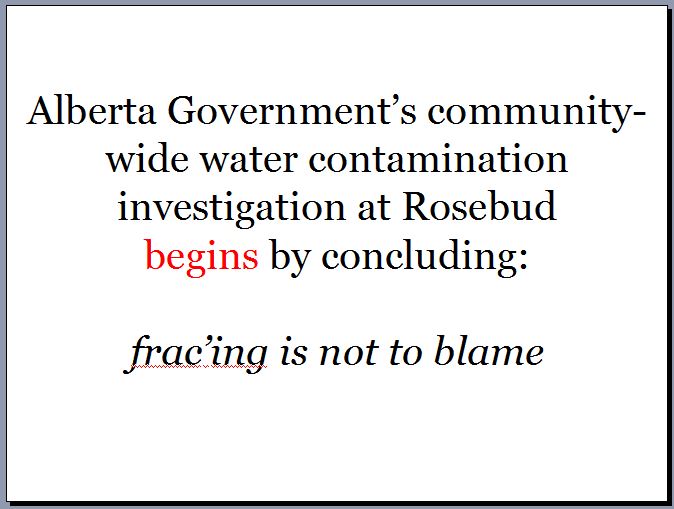
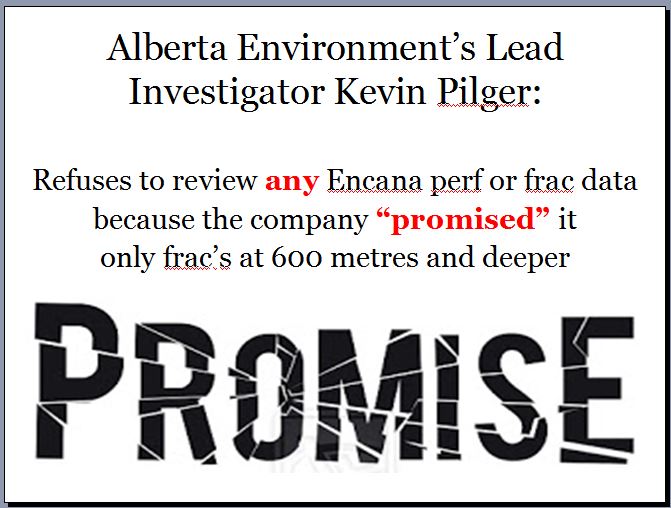
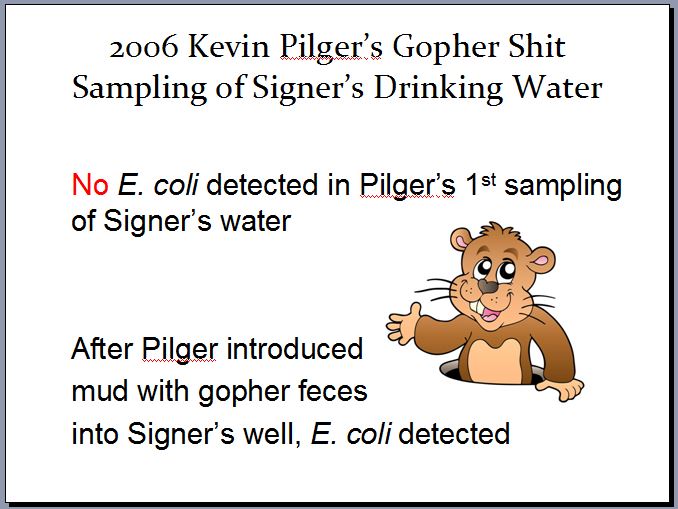
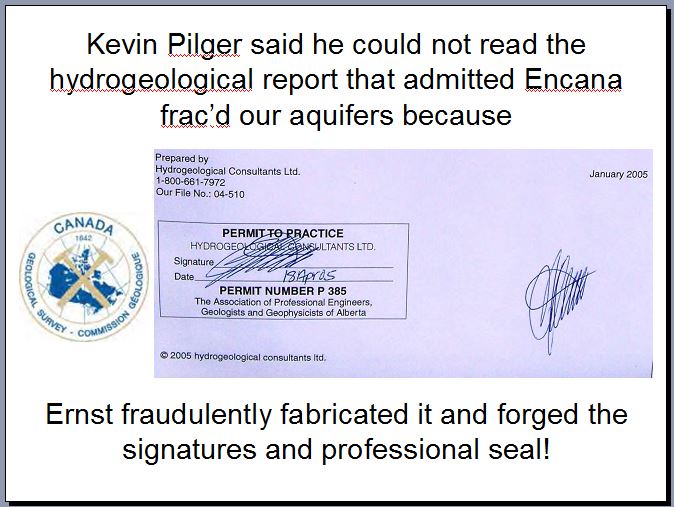
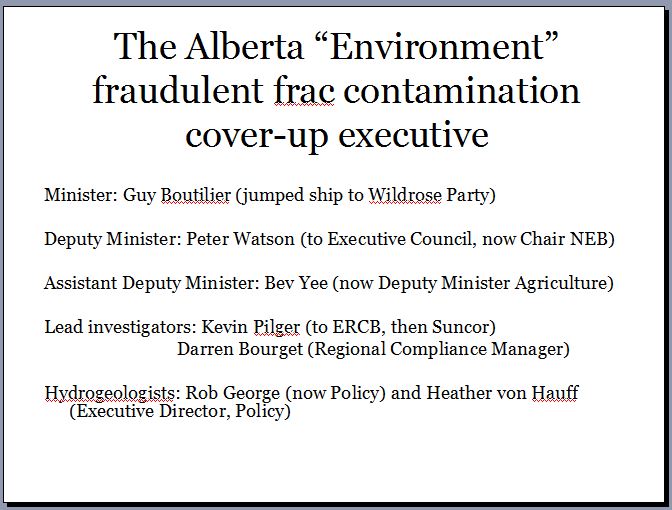
Slides above from Ernst presentations
End Interlude: Compare to Rosebud, Alberta]
“Chevron has thoroughly investigated Mr. Latkanich’s concerns, tested his water, and demonstrated that its operations have not affected Mr. Latkanich’s water,” she said in an email that also said the DEP tested his water in 2013 then six times between February 2017 and March 2019 in response to his complaints and the water supply was “not adversely affected by oil and gas activities.”
But Mr. Latkanich showed the Post-Gazette one DEP test of his well water with measured levels of bromides, chlorides and salts — common contaminants from oil and gas operations. DEP indicated that the levels were within drinking water standards.
Ryan’s deteriorating health led the family to UPMC, where he underwent toxicology testing in May 2018. The final report, made available to the family in May 2019, states, “Overall this is an unfortunate situation, however patient and family members have already removed themselves from the source of exposure, which is the definitive treatment,” referring to the fact that the Latkaniches no longer drink well water.
“Certainly [I] agree with DEP/EPA [U.S. Environmental Protection Agency] involvement to address the source of this exposure,” Dr. Abesamis’ report says.
His main recommendation was for the family to stay away from the source of exposure — their house and its air, in addition to the water, as much as possible.
“How do we do that?” Mr. Latkanich said. “The majority of my wealth is invested in this house and property.”
DEP in the middle
The DEP says it thoroughly investigated the Latkanich water complaint and issued findings on May 14, 2019, indicating that no elevated contamination levels were found.
But John Stolz, director of Duquesne University’s Center for Environmental Research and Education, said chemicals now known to be hazardous aren’t restricted by federal drinking water standards established long before shale gas operations got underway in Pennsylvania. [It’s the same in Canada]
“Bromide showed up in several of Bryan’s water tests and seemed to correlate with an increase in chloride,” he said, having supervised independent water testing on the Latkanich property — at Mr. Latkanich’s request — and having analyzed DEP water test results. “The presence of both can indicate groundwater impacted by brine or produced water. Why the DEP would discount this is puzzling.”
Product of wastewater — produced water or brine — containing bromide is associated with fossil fuel extraction and utilization, the U.S. EPA states online.
So Mr. Stolz said its presence in the Latkanich well water suggests that shale-produced water — water sometimes referred to as fracking fluids — has infiltrated his well.
“DEP will consider water to be safe even when chemicals are present, if the concentrations are below the maximum contaminant level” established by EPA standards, he said. “These standards are based on the general population and do not consider compromised individuals who may be at greater risk for exposure.
“The DEP also has the tendency to come to a negative determination if the levels of contaminants eventually return to ‘pre-drill’ levels, even if there had been a significant change in water quality,” Mr. Stolz said. “This makes it very difficult to defend a landowner’s claim.”
In response, DEP spokeswoman Lauren Fraley said the DEP has no authority to regulate drinking water supplies and can only determine whether or not oil and gas activity has diminished water quality or quantity. But water tests revealed no evidence that oil and gas activity had impacted Latkanich well water, based on repeated water testing and site inspections.
Brine and bromide were present in the well water at fluctuating but low levels but never exceeding statewide drinking water standards and lacking characteristics typical of oil and gas activity. Prior to oil and gas activity, she said, testing showed that Latkanich well water had bacterial contamination above drinking water standards, making it unsafe to drink.
Ms. Fraley said Chevron contends that Mr. Latkanich has denied the company access to parts of his property near the well site, preventing it from permanently restoring the site and complying with the stormwater management requirements of its drilling-related permit.
Mr. Latkanich said he’ll continue to block access to his property until he reaches a financial agreement that covers the house and property damages that he claims have occurred.
But Ms. Flores-Paniagua, the Chevron spokeswoman, said an engineering study concluded that problems with the foundation wall resulted from design flaws, not Chevron operations. She said the company cannot complete restoration of the disputed acreage as long as it is banned from the property.
“We will not speculate on the medical condition of a child,” she said, referring to Ryan. “[Dr. Abesamis] is not a water expert. Water quality is tested by the DEP,” which says it has not found harmful levels of contamination.
Mr. Latkanich said Chevron previously offered him $70,000 to fix the home foundation but also wanted him to sign off on water contamination claims and allow the company to tie up even more of his land by constructing drainage ditches. That caused him to end further negotiations.
“Currently the site is unrestored, and DEP is evaluating options to bring it into compliance,” Ms. Fraley said. “Restoration requirements at the conclusion are applicable to all wells and not related to potential contamination that may be alleged.”
Within days after the DEP responded to Post-Gazette questions about the Latkaniches, the department scheduled a conference with him to resolve their differences.
“While there is no formal arbitration or litigation that DEP is aware of, DEP encouraged both parties to discuss site restoration during a conference,” Ms. Fraley said.
Mr. Latkanich said he took his son and a friend — an environmental activist — with him to the conference in early June. But he said the DEP told the activist and Ryan to leave the meeting before it began. That left him alone with a DEP attorney, two DEP managers and a field inspector, two Chevron attorneys and three other company officials — nine people in all.
“I wasn’t prepared,” he said.
But he did offer — off the top of his head, he said — a settlement amount considerably higher than the $70,000 the company had offered for damage to his house and property. His figure also included losses from the commercial vegetable business he has been unable to start. Within days, he said, he received written notification that Chevron wanted to take the issue to neutral arbitration. Chevron did not comment to the Post-Gazette on settlement amounts.
“It is our hope to amicably resolve all of Mr. Latkanich’s concerns,” Ms. Flores-Paniagua said. “Look, we do care about the community and adhere to local, state and federal regulations and do our best to be responsible operators.”
Mr. Latkanich said if the company were truly amicable, it would have met his price for settling claims of property and house damage, rather than pushing for arbitration.
Ryan still has health issues but has been attending classes in the Bethlehem Center School District.
“Nothing is resolved because they do what they want and deny that anything happened,” Mr. Latkanich said. “I have a sick kid, and a medical professional is telling me why.
“Who do you believe when I have a sick kid and I’m sickened by it, too?’ he said. “I’ve just been through hell.”
Refer also to:
